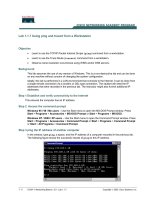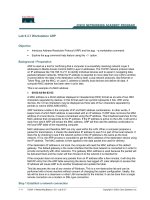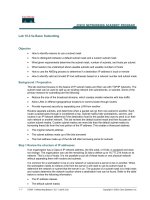Tài liệu Lab 9.3.7 Workstation ARP pdf
Bạn đang xem bản rút gọn của tài liệu. Xem và tải ngay bản đầy đủ của tài liệu tại đây (125.13 KB, 4 trang )
1 - 4 CCNA 1: Networking Basics v 3.0 - Lab 9.3.7 Copyright 2003, Cisco Systems, Inc.
Lab 9.3.7 Workstation ARP
Objective
• Introduce Address Resolution Protocol (ARP) and the arp –a workstation command.
• Explore the arp command help feature using the -? option.
Background / Preparation
ARP is used as a tool for confirming that a computer is successfully resolving network Layer 3
addresses to Media Access Control (MAC) Layer 2 addresses. The TCP/IP network protocol relies
on IP addresses like 192.168.14.211 to identify individual devices and to assist in navigating data
packets between networks. While the IP address is essential to move data from one LAN to another,
it cannot deliver the data in the destination LAN by itself. Local network protocols, like Ethernet or
Token Ring, use the MAC, or Layer 2, address to identify local devices and deliver all data. A
computer MAC address has been seen in prior labs.
This is an example of a MAC address:
• 00-02-A5-9A-63-5C
A MAC address is a 48-bit address displayed in Hexadecimal (HEX) format. In this format each hex
symbol represents 4 bits. The first half, or 24-bits, 00-02-A5 identifies the network interface card
(NIC) manufacturer. In this case it is the manufacturer is Compaq. The good news is that it is not
necessary to know this address to deliver data within the network. The only thing needed is an IP
address.
ARP maintains a table in the computer of IP and MAC address combinations. In other words, it
keeps track of which MAC address is associated with an IP address. If ARP does not know the MAC
address of a local device, it issues a broadcast using the IP address. This broadcast searches for the
MAC address that corresponds to the IP address. If the IP address is active on the LAN, it will send a
reply from which ARP will extract the MAC address. ARP will then add the address combination to
the local ARP table of the requesting computer.
MAC addresses and therefore ARP are only used within the LAN. When a computer prepares a
packet for transmission, it checks the destination IP address to see if it is part of the local network. It
does this by checking to see if the network portion of the IP address is the same as the local
network. If it is, the ARP process is consulted to get the MAC address of the destination device using
the IP address. The MAC address is then applied to the data packet and used for delivery.
If the destination IP address is not local, the computer will need the MAC address of the default
gateway. The default gateway is the router interface that the local network is connected to in order to
provide connectivity with other networks. The gateway MAC address is used because the packet will
be delivered there and the router will then forward it to the network it is intended for.
If the computer does not receive any packets from an IP address after a few minutes, it will drop the
MAC/IP entry from the ARP table assuming the device has logged off. Later attempts to access that
IP address will cause ARP to do another broadcast and update the table.
This lab assumes the use of any version of Windows. This is a non-destructive lab and can be
performed with a home machine without concern of changing the system configuration. Ideally, this
lab will be done in a classroom or other LAN connected to the Internet. It can be done from a single
remote connection via a modem or DSL-type connection.
2 - 4 CCNA 1: Networking Basics v 3.0 - Lab 9.3.7 Copyright 2003, Cisco Systems, Inc.
Step 1 Establish a network connection
If the connection to the Internet is dial-up, connect to the ISP to ensure that the computer has an IP
address. In a TCP/IP LAN with a Dynamic Host Configuration Protocol (DHCP) server it should not
be necessary to do this step.
Step 2 Access a command prompt
Windows NT / 2000 / XP users:
Use the Start menu to open the Command Prompt window. This window is similar to the MS-DOS
window on older Windows versions:
Start > Programs > Accessories > Command Prompt or Start > Programs > Command Prompt
Windows 95 / 98 / ME users:
Use the Start menu to open the MS-DOS Prompt window:
Start > Programs > Accessories > MS-DOS Prompt or Start > Programs > MS-DOS Prompt
Step 3 Display the ARP table
a. In the window type arp -a and press Enter. Do not be surprised if there are no entries. The
message displayed will probably be, ‘No ARP Entries Found’. Windows computers remove any
addresses that are unused after a couple minutes.
b. Try pinging a couple local addresses and a website URL. Then re-run the command. The figure
below shows a possible result of the arp -a command. The MAC address for the website will
be listed because it is not local, but that will cause the default gateway to be listed. In the
example below 10.36.13.1 is the default gateway while the 10.36.13.92 and 10.36.13.101 are
other network computers. Notice that for each IP address there is a Physical Address, or MAC,
and type, indicating how the address was learned.
Step 4 Ping several URLs
a. Ping the following URLs and note the IP address of each. Also select one additional URL to ping
and record it below:
www.cisco.com
: _____________________________
www.msn.de
: _______________________________
______________: ____________________________
b. Now run the arp –a command again and record the MAC addresses for each of the above next
to their IP addresses. Can it be done? ___________________________
c. Why or why not? ___________________________________________________
__________________________________________________________________
d. What MAC address was used in delivering each of the pings to the URLs? ______
_______________________ Why? _____________________________________
3 - 4 CCNA 1: Networking Basics v 3.0 - Lab 9.3.7 Copyright 2003, Cisco Systems, Inc.
Step 4 Use the ARP help feature
Try the command arp -? to see the help feature and look over the options.
The purpose of this step is not so much the ARP command options but to demonstrate using the ? to
access help, if available. Help is not always implemented uniformly. Some commands use /?
instead of -?.
Step 5 Use help with tracert and ping
Try tracert -? and then ping -? to see the options available for the commands used previously.
In looking at the help for ping, notice the –t option, which will send continuous pings, not just four.
More importantly, notice the two commands to stop it:
• Control-Break
4 - 4 CCNA 1: Networking Basics v 3.0 - Lab 9.3.7 Copyright 2003, Cisco Systems, Inc.
• Control-C
These two-key commands are common for stopping runaway activities. Try pinging a neighboring
computer with the -t option and then try the Control-Break and Control-C features. An example in the
above network would be ping 10.36.13.101 -t and then press Enter.
Be sure to use the Control-C command to stop the pings.
Reflection
Based on observations made today, what could be deduced about the following results?
Computer 1
IP Address: 192.168.12.113
Subnet Mask: 255.255.255.0
Default Gateway: 192.168.12.1
Pings and tracert to 207.46.28.116 were both successful.
What will be the ARP table entry associated with this address and why?









